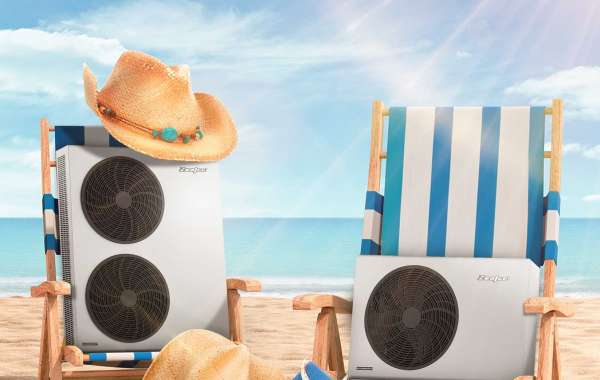一:Understanding Solar Systems for Heating and Cooling
Solar energy is a renewable and sustainable source of power that can be harnessed for heating and cooling purposes.
(1)How Solar Systems Work
Solar systems for heating and cooling work by harnessing the power of sunlight. Here's a simplified explanation of how they operate:
- Absorption of Solar Energy: Solar collectors, often mounted on the roof or in an open area with good sun exposure, absorb sunlight. The collectors are designed to capture as much solar energy as possible.
- Conversion of Solar Energy: In solar water heating systems, the absorbed solar energy heats the water passing through the collectors. Solar air heating systems heat the air directly, while solar thermal cooling systems use the solar energy to drive cooling processes.
- Storage and Distribution: The heated water or air is stored in tanks or distributed through a network of pipes or ducts, depending on the system type. This ensures that the heat or cooling is readily available when needed.
二:Introduction to Heat Pumps for Sustainable Heating and Cooling
Heat pumps are an efficient and sustainable technology that can be used for heating and cooling applications.
(1)How Heat Pumps Work
Heat pumps work based on the principle of transferring heat from one place to another. Here's a simplified explanation of how they operate:
- Heat Absorption: The heat pump absorbs heat from a heat source, which could be outdoor air, the ground, or a water source, depending on the type of heat pump. This is achieved using a refrigerant that can extract heat from the source even at low temperatures.
- Compression: The absorbed heat is then compressed by the heat pump's compressor, which increases its temperature.
- Heat Distribution: The compressed and heated refrigerant releases the heat into the indoor space for heating or transfers it to an external medium, such as the ground or water source, for cooling.
- Expansion and Evaporation: After releasing the heat, the refrigerant expands and evaporates, returning to a low-pressure state.
- Heat Absorption (Reversing Valve): In cooling mode, the reversing valve in the heat pump switches the flow direction of the refrigerant, allowing it to absorb heat from the indoor space and release it outside, thus cooling the indoor environment.
By utilizing this heat transfer process, heat pumps can efficiently provide heating and cooling without directly relying on fossil fuels.
In conclusion, Zealux inverboost air to water heat pump system offer a sustainable and energy-efficient solution for heating and cooling needs. Understanding the different types of heat pumps available and how they work can help individuals and businesses make informed decisions about implementing this technology for their heating and cooling requirements. If you want to learn more please contact air to water heat pump manufacturer.
三:Best Practices for Operating and Maintaining Solar Systems and Heat Pumps
Proper operation and maintenance are crucial for ensuring the optimal performance and longevity of solar systems and heat pumps. In this article, we will discuss best practices for operating and maintaining both solar systems and heat pumps, as well as troubleshooting common issues that may arise.
(1)Proper Use and Maintenance of Solar Systems
- Regular Inspection: Schedule regular inspections of your solar system to identify any signs of damage, wear, or malfunction. This includes checking the solar collectors, pipes, valves, and storage tanks.
- Cleaning: Keep the solar collectors clean and free from dirt, dust, leaves, or any other obstructions that may hinder their efficiency. Regularly clean the glass surface of the collectors to maximize sunlight absorption.
- Monitoring and Adjusting: Monitor the performance of your solar system, including the temperature of the heated water or air and the overall energy production. Adjust system settings as needed to optimize efficiency.
- System Flushing: Periodically flush the solar system to remove any sediment or mineral deposits that may accumulate over time. This helps maintain proper flow and heat transfer within the system.
- Professional Maintenance: Engage a professional service provider to conduct routine maintenance and address any complex issues. They can ensure proper system operation, inspect and repair components, and perform system tests for efficiency.
(2)Proper Use and Maintenance of Heat Pumps
- Filter Maintenance: Regularly clean or replace the air filters in your heat pump to maintain proper airflow and prevent dust or debris from clogging the system. Follow the manufacturer's guidelines for the recommended maintenance schedule.
- Outdoor Unit Maintenance: Keep the outdoor unit of the heat pump clear of debris, leaves, and vegetation. Ensure proper airflow around the unit and remove any obstructions that may affect its efficiency.
- Duct Inspection: Inspect the ductwork regularly for any leaks, gaps, or damage. Properly sealed and insulated ducts improve system efficiency and performance.
- Refrigerant Levels: Check the refrigerant levels of your heat pump regularly. Low levels can indicate a leak or other issues that need to be addressed by a qualified technician.
- Professional Service: Schedule annual maintenance visits by a professional HVAC technician. They can inspect and clean the internal components, check electrical connections, and ensure the overall performance and efficiency of the heat pump.
(3)Troubleshooting Common Issues
- Insufficient Heating/Cooling: Check the thermostat settings to ensure they are set correctly. Inspect and clean the air filters, as dirty filters can restrict airflow. Verify that the heat pump is not obstructed and that all settings are functioning properly.
- System Malfunction: If the solar system or heat pump is not operating as expected, check the power supply, circuit breakers, and fuses. Reset any tripped breakers or replace blown fuses.
- Water Leaks: Inspect the plumbing connections and pipes of the solar system for any leaks. Tighten any loose fittings or joints and repair any damaged parts promptly.
- Unusual Noises: If you notice unusual noises coming from the solar system or heat pump, such as rattling, grinding, or squealing sounds, contact a professional technician to diagnose and address the issue.
Remember to refer to the heat pump manufacturer's instructions and guidelines for specific maintenance requirements and recommended practices for your solar system or heat pump. By following these best practices and promptly addressing any issues, you can maximize the performance, energy efficiency, and lifespan of your solar system and heat pump.










